Episodes
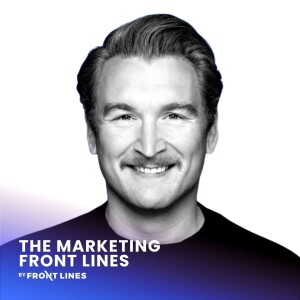
Monday Jun 02, 2025
Monday Jun 02, 2025
In this episode of The Marketing Front Lines, we speak with Philipp de la Haye, Senior Vice President of Marketing at FrontNow. FrontNow is transforming omnichannel retail by using GenAI to replicate the in-store shopping experience online, helping retailers who are strong offline but struggle to compete with Amazon and other marketplaces online. After joining FrontNow eight months ago, Philipp completely transformed their marketing approach from generic brand building to a highly tactical, event-driven strategy that has delivered 170% of their lead generation targets. His unconventional "Navy SEAL approach" to events and focus on building trust over selling has created a scalable playbook for B2B tech companies targeting enterprise clients.
Topics Discussed:
Transitioning from brand building to tactical lead generation in B2B SaaS
The "Navy SEAL approach" to event marketing that delivers 87 MQLs from 205 attendees
Why traditional lead gen tactics (webinars, whitepapers, gated content) are failing
Building trust-first marketing strategies for complex B2B sales cycles
Reducing touchpoints to maintain quality control over customer experience
How AI is fundamentally changing marketing operations and team structure
The acceleration of AI technology and its impact on business model sustainability
Lessons For B2B Tech Marketers:
Execute the "Navy SEAL Approach" to Event Marketing: Instead of expensive trade show booths requiring multiple team members, book 1-1.5 hour speaker slots for masterclasses. Bring existing customers or partners on stage to discuss their challenges and solutions, creating authentic case studies. This approach requires minimal resources (1-2 people, half-day commitment) while generating high-quality attendee lists for follow-up. Philipp generated 87 MQLs (company-level, not individual contacts) from 205 event attendees using this method.
Prioritize Trust Building Over Direct Selling: In B2B tech, prospects are always at risk since they can't validate your solution works until 6-12 months into implementation. Instead of pushing product demos and sales calls immediately, focus first on proving your products work through customer testimonials and case studies. This approach acknowledges that B2B marketing is fundamentally about building trust, not just generating leads.
Strategically Reduce Touchpoints for Quality Control: Rather than trying to optimize every possible customer touchpoint, deliberately reduce the number of touchpoints to only those you can control and manage at high quality. Think of marketing like cooking - you could use every spice in your pantry, but the best dishes use only the spices that complement the specific taste preferences of who you're serving.
Abandon Traditional Lead Gen Tactics That Don't Deliver Value: Webinars, whitepapers, and gated content have become commoditized and provide minimal value to sophisticated B2B buyers. These tactics often create negative experiences (immediate sales calls after webinar signup) that damage trust. Focus on delivering genuine value through educational content and real customer stories instead of promotional materials.
Plan for AI-Driven Team Structure Changes: AI is fundamentally changing marketing operations. Philipp originally planned for a 5-8 person marketing team within 24 months but now expects maximum 2 people for the same growth targets. Skills-based specialists can be hired as freelancers for 3-6 month projects, with AI handling ongoing execution. Marketing leaders should spend 20% of their time learning new AI technologies and applications.
Question Every Plan and Assumption Continuously: Every forecast, plan, and idea becomes outdated the moment it's finalized. Successful B2B marketers must be brave enough to abandon their own plans when data shows different results. This requires honest self-assessment and willingness to admit incorrect assumptions rather than sticking to predetermined strategies that aren't working.
//
Sponsors:
Front Lines — We help B2B tech companies launch, manage, and grow podcasts that drive demand, awareness, and thought leadership.
www.FrontLines.io
The Global Talent Co. — We help tech startups find, vet, hire, pay, and retain amazing marketing talent that costs 50-70% less than the US & Europe.
www.GlobalTalent.co

Monday Jun 02, 2025
Monday Jun 02, 2025
In this episode of The Marketing Front Lines, we speak with Carolyn Crandall, a seasoned marketing executive who has spent four decades in B2B tech marketing, from the early days of Cisco and Juniper to her most recent role at Attivo Networks (acquired by SentinelOne for over $600M). After transitioning from full-time executive roles to fractional CMO work, Carolyn shares the tactical realities of building a fractional practice, the red flags to watch for when evaluating clients, and the specific strategies that work when you have limited time to deliver maximum impact.
Topics Discussed:
Transitioning from full-time CMO to fractional consultant
Identifying red flags in potential fractional partnerships
Building efficient tech stacks for early-stage companies
Moving "left of MQL" with AI-powered engagement
Managing multiple fractional clients simultaneously
Pricing strategies and contract structures for fractional work
Lessons For B2B Marketing Leaders:
Structure Fractional Contracts for Success: Carolyn recommends four-month minimum contracts for fractional CMO work. This provides enough time to understand the business, build programs, execute, and measure results without being locked into problematic relationships. Shorter engagements don't allow for meaningful impact, while longer initial commitments can trap you with difficult clients.
Move Left of MQL with AI-Powered Outreach: Rather than waiting for qualified leads, use AI and automation to engage prospects immediately when they hit your website. Set up separate domains for aggressive outreach using tools like Lemlist or Clay to protect your primary domain reputation, while keeping HubSpot clean for engaged prospects.
Avoid Expensive ABM Platforms Until You Have Operators: Tools like 6sense and Demandbase are powerful but require dedicated operators to extract value. Early-stage companies often waste money on these platforms when simpler tools like Apollo, LinkedIn automation, and targeted databases can achieve similar results at a fraction of the cost.
Train AI Tools as Your Marketing Assistant: Develop a working relationship with ChatGPT or Claude by creating custom projects and training them on your voice and style. Use AI not just for content creation but as an editor, strategist, and quality checker. Test your AI-generated content through AI detection tools to ensure it doesn't sound robotic.
Evaluate Cultural Fit During the Sales Process: Red flags include CEOs who expect unrealistic results, want to work exclusively through you rather than embedding you with the team, or give you KPIs without providing resources for execution. Ask specific questions about meeting expectations, collaboration style, and performance metrics upfront.
Build Your Fractional Network Before You Need It: Success as a fractional CMO often comes through referrals from VCs, former colleagues, and vendor partners. Start building these relationships while you're still in full-time roles. Have a clear answer for why you're choosing fractional work beyond "I'm looking for full-time work in the interim."
Invest in Foundational Tech Stack Elements: Don't cut corners on essential infrastructure like marketing automation setup, website development, and initial content creation. Poor implementation of tools like HubSpot or Salesforce creates long-term problems that are expensive to fix later. Budget appropriately for professional setup and configuration.
Maintain Industry Focus for Operational Efficiency: Specializing in similar industries (like cybersecurity) allows you to reuse playbooks, understand buyer personas deeply, and leverage existing industry relationships. Taking on clients across vastly different industries requires significant additional learning time and reduces your efficiency.
//
Sponsors:
Front Lines — We help B2B tech companies launch, manage, and grow podcasts that drive demand, awareness, and thought leadership.
www.FrontLines.io
The Global Talent Co. — We help tech startups find, vet, hire, pay, and retain amazing marketing talent that costs 50-70% less than the US & Europe.
www.GlobalTalent.co

Friday May 30, 2025
Friday May 30, 2025
In this episode of The Marketing Front Lines, we speak with Jayashree Rajan, CMO of Nexla. With an engineering background that evolved into marketing leadership, Jayashree shares how she transformed Nexla's marketing approach from founder-led sales to a sophisticated, data-driven operation. She discusses the radical transformation of her marketing program over just eight months - implementing digital expansion strategies across multiple platforms, developing targeted vertical approaches focused on use cases, and establishing full-funnel nurturing systems. As a passionate advocate for data-driven marketing decisions, Jayashree provides candid insights on which tactics she kept, which she eliminated, and how AI is revolutionizing her team's productivity.
Topics Discussed:
Transforming from untargeted to targeted marketing approaches
Data-driven evaluation of marketing channels and programs
Re-engineering outbound motions for higher efficiency
Making tough decisions about events, influencer marketing, and content creation
Balancing immediate pipeline generation with long-term brand building
Using AI to dramatically increase marketing team productivity
Evolving marketing team structures in the age of AI
Lessons For B2B Tech Marketers:
Implement Targeted Marketing Motions: Nexla shifted from untargeted calling to a focused approach identifying specific use cases, verticals, and personas before outreach. This targeting principle extends across all channels - events, influencers, and content - improving efficiency and ROI.
Make Data-Driven Decisions About Marketing Programs: Before continuing with any marketing program, rigorously evaluate performance data. Jayashree discontinued community events, long-form content creation, and most influencer relationships after data showed they weren't driving pipeline despite generating engagement.
Execute Multi-Touch Outbound Campaigns: Rather than unlimited cold calling, Nexla now uses time-boxed, multi-channel outreach with coordinated touches across phone, email, and LinkedIn. This focused approach conserves resources while increasing effectiveness.
Balance Immediate Pipeline with Long-Term Brand Building: While prioritizing immediate pipeline generation, Jayashree still invests in targeted events and carefully selected influencer relationships that align with their market and geography, maintaining brand awareness that will drive future opportunities.
Integrate AI Throughout Your Marketing Stack: Jayashree urges marketers to become "AI marketers" by integrating AI into daily workflows. Her team uses AI for content creation, headline testing, idea generation, and conversation analysis. She views AI as a "reliable team member" that enables a small team to accomplish significantly more work with higher quality.
Challenge Attribution Myths: Rather than focusing on first-touch or last-touch attribution models, concentrate on whether marketing efforts ultimately convert to meetings, pipeline, and opportunities. Measuring marketing solely by MQLs and leads without connecting to pipeline outcomes is misleading.
Adapt to Marketing Team Evolution: The future of B2B marketing will involve smaller, more versatile teams of "AI marketers" rather than specialists. Jayashree runs a highly effective marketing operation with just four core marketers by leveraging AI and modern martech solutions to increase efficiency.
//
Sponsors:
Front Lines — We help B2B tech companies launch, manage, and grow podcasts that drive demand, awareness, and thought leadership.
www.FrontLines.io
The Global Talent Co. — We help tech startups find, vet, hire, pay, and retain amazing marketing talent that costs 50-70% less than the US & Europe.
www.GlobalTalent.co
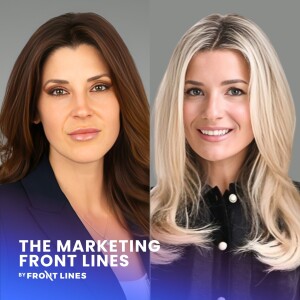
Friday May 30, 2025
Friday May 30, 2025
In this episode of The Marketing Front Lines, SVP of Market Caitlin Allen and Growth Marketing Manager Lexie Sirak from Simbe Robotics reveal how they've built a powerhouse event marketing strategy that drove 70% of the company's net new pipeline in 2024 - more than all previous years combined. They share their three-tiered approach to market development through events, creative booth strategies (including turning half their booth into a podcast studio), and practical frameworks for maximizing ROI without massive budgets.
Topics Discussed:
Building a three-tiered event strategy mapped to market development stages
Using a "crawl, walk, run" approach for resource-efficient event participation
Creating differentiated experiences that transcend traditional booth presence
Maximizing ROI through strategic pre- and post-event activation
Implementing a 10x ROI measurement model for event investments
Generating 70% of net new pipeline from event-driven strategies
Executing effective event follow-up that converts prospects into customers
Lessons for B2B Event Marketers:
Think Beyond The Booth as "Anchor, Not Focal Point": While many companies over-invest in elaborate booths, Simbe treats their booth as an anchor point, not the centerpiece of their event strategy. They think creatively about how to show up larger than their physical footprint, strategically partnering with others to secure multiple placements, and focusing event resources on creating connections rather than just aesthetics.
Approach Events Through Three Strategic Lenses: Simbe filters all event decisions through three strategic priorities: establishing market leadership in core verticals (grocery/supermarket), expanding into adjacent segments (home improvement, farm supply), and elevating their existing customer relationships. This framework prevents reactive event participation and ensures all investments align with company objectives.
Leverage Creative Partnerships to Multiply Your Presence: At major industry events like NRF, Simbe secured presence in three different booths - only one being their own - by strategically partnering with complementary companies. This allowed them to appear on the main floor without paying the premium typically required, significantly amplifying their visibility while managing costs.
Create Event-Adjacent Experiences That Match Audience Mindset: Instead of forcing traditional sales conversations in environments where executives aren't in buying mode, Simbe creates adjacent experiences matched to attendee priorities. Examples include hosting a spa day for retail executive award winners and converting half their booth into a podcast studio featuring industry thought leaders - attracting exactly the right audience without interrupting their primary reason for attending.
Transform Events into Multi-Channel Campaigns: Simbe's most successful events are treated as omnichannel campaigns spanning weeks, not days. For their NRF announcement, they created an "echo chamber" effect through podcast placements, earned media, partner amplification, and targeted outreach before the event, followed by at-event amplification and structured follow-up campaigns. This integrated approach ensures maximum impact from each event investment.
Implement "Blitz" Philosophy for Maximum Visibility: For marquee industry events, Simbe deploys a comprehensive "blitz" strategy - combining strategic pre-event announcements, VIP preview events, omnichannel activation, and coordinated on-site presence. This approach creates an impression of omnipresence that helps them compete with much larger companies who have significantly larger budgets.
Certify Every Team Member as an Event Ambassador: Simbe requires every event attendee across departments to complete an "elevator pitch certification" before representing the company at events. This ensures everyone can effectively communicate the company's value proposition, maximizing every interaction opportunity regardless of the team member's primary role.
//
Sponsors:
Front Lines — We help B2B tech companies launch, manage, and grow podcasts that drive demand, awareness, and thought leadership.
www.FrontLines.io
The Global Talent Co. — We help tech startups find, vet, hire, pay, and retain amazing marketing talent that costs 50-70% less than the US & Europe.
www.GlobalTalent.co
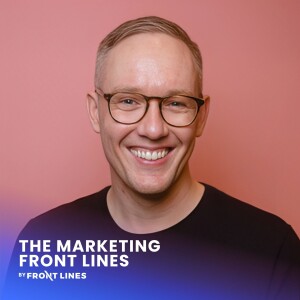
Wednesday May 21, 2025
Wednesday May 21, 2025
In this episode of Marketing Front Lines, we speak with Bryan McCarty, Director of Product and Product Marketing at Orum. Bryan shares how his background in the punk rock scene shaped his DIY marketing ethos and unpacks Orum's innovative event strategy that's setting them apart in the FinTech space. A veteran of the FinTech world since 2011, Bryan discusses his philosophy that "your work's not done until you tell the world about it," and reveals the strategic playbook that's helped Orum stand out at major industry events through experiential marketing and perfect launch timing.
Topics Discussed:
Orchestrating product launches to strategically precede major industry events
Creating memorable experiential marketing moments that buck conventional event strategies
The blurred lines between product and product marketing responsibilities
Balancing technical documentation as part of the overall product experience
Rethinking thought leadership content in an AI-driven search landscape
Leveraging social media to build authentic product narratives
Lessons For B2B Tech Marketers:
Time Your Product Launches Strategically Before Major Events: Orum launches products 2-3 weeks before major FinTech conferences, creating awareness that pays off when prospects arrive at the event. By the time attendees show up, they've already seen Orum's product announcements in their feeds and arrive with context and curiosity. This approach "expedites the conversation" and sets them apart from competitors who launch during the event when everyone is fighting for attention.
Create Experiential Marketing That Offers Relief From Conference Chaos: Rather than another noisy booth, Orum takes over a donut shop near major FinTech events, transforming it into an Orum-branded space. The key difference: their sales team is explicitly instructed not to pitch inside the space. Instead, it serves as a respite from the conference, allowing meaningful connections while giving attendees "a moment to decompress." This approach has created such buzz that attendees now actively seek them out asking, "Are you doing the donuts again?"
Develop A Master Brand Framework That Keeps Everyone Aligned: Orum uses a comprehensive master brand framework that goes beyond typical messaging documents. Every employee has it as desktop wallpaper, ensuring alignment on messaging. More importantly, they use it as a product development filter - when building new features, they evaluate whether it ties back to their core pillars. This creates a powerful feedback loop where marketing and product development stay in lockstep.
Cross-Pollinate Between Technical And Marketing Teams: Product marketers should immerse themselves in engineering culture by attending standups and technical meetings. Bryan credits much of his career success to being "forced to learn things and ask questions" in technical environments, leading to more effective collaboration when building and launching products. This cross-functional knowledge pays "tenfold dividends" when collaborating on launches.
Rethink "Thought Leadership" Content Strategy In The AI Era: Traditional SEO and keyword-focused "industry knowledge" content is "going through the ringer" with the rise of AI search tools. Bryan notes that Orum has moved away from generic thought leadership content that wasn't providing value. As users shift from Google to AI assistants for information, B2B marketers need to reconsider how they approach content that's traditionally been designed to capture search traffic.
Build In Public With Authentic Product Updates: Bryan admires how companies like Pylon effectively show their product development journey through consistent social posts featuring GIFs and videos of platform updates. This approach makes followers feel like they're "in the room" as features are shipped, creating an authentic connection to the product development process. The slightly raw, unpolished nature of these updates adds to their authenticity and effectiveness.
//
Sponsors:
Front Lines — We help B2B tech companies launch, manage, and grow podcasts that drive demand, awareness, and thought leadership.
www.FrontLines.io
The Global Talent Co. — We help tech startups find, vet, hire, pay, and retain amazing marketing talent that costs 50-70% less than the US & Europe.
www.GlobalTalent.co
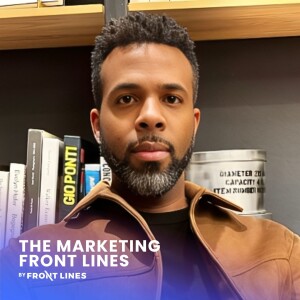
Tuesday May 20, 2025
Tuesday May 20, 2025
In this episode of The Marketing Front Lines, we speak with Corey Washington, Senior Marketing Manager at Amenities Health. Amenities Health gives health systems a turnkey solution to compete with retail concierge care players like One Medical by offering premium concierge care memberships delivered entirely under the health system's brand. The company eliminates operational lift, resource strain, and capital investment while driving revenue, network utilization, and patient loyalty for health systems. Corey shares how their distinctive "campy" brand aesthetic sets them apart in the traditionally sterile healthcare tech space, his philosophy on human-centered marketing, and why marketers should view AI as a "brainstorm buddy" rather than a replacement.
Topics Discussed:
Creating distinctive, human-centered brand identities in healthcare tech
Using a "build your seat at the table" approach to career advancement
Developing marketing philosophies that emphasize human connection
Leveraging thought leadership and employee evangelism effectively
Finding the right balance between data-driven decisions and human experiences
Selecting high-ROI marketing channels for healthcare technology startups
Working with AI as a collaborative tool rather than a replacement for creativity
Lessons For B2B Tech Marketers:
Speak the Language of Your Audience: Ruthlessly eliminate jargon and tech-speak from your messaging. As Corey emphasizes, "Nothing is more irritating than when you're trying to get to know a brand and you're trying to translate hieroglyphics to understand what they do." Healthcare tech companies particularly benefit from translating complex solutions into clear, human terms.
Brand Differentiation Matters Even in Technical Markets: Amenities Health stands out with its warm, "campy" branding in a sea of sterile healthcare tech websites. Their A-frame cabin motif and outdoor theme create memorability that has customers at trade shows consistently praising their distinctive look. Even in B2B tech, distinctive visual identity creates significant competitive advantage.
Make AI Your "Brainstorm Buddy": Use AI to structure brain dumps, refine raw ideas, and perform initial research, but maintain human oversight for strategy, empathy, and authenticity. As Corey notes, "AI is there to take my brain dump and structure it in a way where I can take it and do something with it," not replace marketer judgment. Even with AI tools, content creation still requires significant human input (turning a 5-7 hour writing job into a 2-hour collaborative process).
Balance Data-Guided Decisions with Human Experience: While data should inform marketing decisions, never forget there's a human behind every keyboard and transaction. Prioritize customer experience even when data suggests otherwise—frustrated customers represent hidden costs not captured in conversion metrics.
Leverage Human Stories Over Corporate Messaging: Amenities Health is pivoting their strategy to highlight their leadership team's expertise and stories rather than focusing purely on product messaging. This "inside-out" approach leverages team members' credibility and passion while humanizing their brand. People follow people, not companies.
Make It Beautiful AND Believable: Quality visual design isn't optional—it's fundamental to communicating brand values. As Corey emphasizes, "I want to make sure our marketing is humanized...that it tells a wonderful visual story that draws people in, that they can relate to, that makes it feel as if we care about what we present." Strong design signals attention to quality across all aspects of your business.
Be a "Swiss Army Knife" Marketer: Develop versatility across multiple marketing disciplines rather than specializing too narrowly. Technical understanding, creative skills, and strategic thinking combine to make you more valuable. As Corey advises younger marketers, "Do not be a one-trick pony marketer...Being able to be comfortable with many different forms of marketing and if you don't know it, being comfortable to say, 'I'm going to learn it.'"
//
Sponsors:
Front Lines — We help B2B tech companies launch, manage, and grow podcasts that drive demand, awareness, and thought leadership.
www.FrontLines.io
The Global Talent Co. — We help tech startups find, vet, hire, pay, and retain amazing marketing talent that costs 50-70% less than the US & Europe.
www.GlobalTalent.co
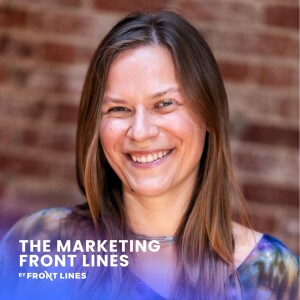
Monday May 19, 2025
Monday May 19, 2025
In this episode of The Marketing Front Lines, we speak with Jocelyn Nowak, Marketing & Sales Enablement Lead at FIGUR8. FIGUR8 has revolutionized musculoskeletal assessment by miniaturizing complex biomechanical measurement technology into a laptop-sized device, bringing objective data to a historically subjective field. With deployment in over 3,000 physical therapy clinics nationwide, FIGUR8 is accelerating patient recovery by 20-40% while providing therapists with data-driven insights that enhance treatment decisions and patient motivation. Jocelyn shares her philosophy of integrity-driven marketing in healthcare technology and how transparent processes enable a small marketing team to maintain alignment with fast-growing clinical operations.
Topics Discussed:
Bringing objectivity to musculoskeletal healthcare through miniaturized biomechanical assessment technology
Building ethical, transparent marketing processes in regulated healthcare environments
Designing effective cross-functional content review workflows when you're a marketing team of one
Transitioning into tech marketing and evaluating culture fit in fast-paced startups
Creating work boundaries that enhance creativity and prevent burnout in always-connected environments
Lessons For B2B Tech Marketers:
Build Systems of Transparency from Day One: When you're a marketing team of one, establish clear task tracking and project management systems immediately—even if it's just a Google Sheet. This transparency becomes invaluable as the company scales and more stakeholders want visibility into marketing priorities. These systems preserve trust when requests flood in from multiple departments, allowing you to demonstrate accountability without sacrificing productive time for constant status updates.
Cultivate Cross-Functional Content Review Processes: In highly technical or regulated industries, establish streamlined review processes that maintain content integrity while respecting everyone's time. At FIGUR8, clinical teams review marketing materials to ensure accuracy and ethical messaging—a process that could become a bottleneck without proper systems. Design workflows that provide necessary oversight without sacrificing agility, particularly when technical accuracy is non-negotiable.
Lead with Integrity When Your Product Actually Delivers: When your product genuinely transforms outcomes (like FIGUR8's 20-40% faster recovery rates), you can market from a position of transparent integrity rather than hype. Nowak notes that FIGUR8 often "undersells" its capabilities—a refreshing position in healthcare tech where trust is paramount. Let objective results drive your messaging rather than sensationalized claims, especially when working with sophisticated B2B buyers.
Evaluate Tech Company Culture Through Founder Dynamics: Before joining a startup, examine the founder's communication style and company culture as these will directly impact your daily experience. Nowak emphasizes the importance of alignment with leadership values, noting that in early-stage companies, "the culture that the founder has as an individual...is going to directly impact you every day." Use the interview process to assess these dynamics and be authentic about your own expectations.
Create Intentional Disconnection to Fuel Marketing Creativity: The constant connectivity of tech environments can drain creative energy and focus. Nowak deliberately separates from technology during walks and personal time—even using a flip phone at times—to maintain creative flow and mental clarity. This intentional disconnection creates the space needed for strategic thinking and differentiates high-integrity marketing from attention-stealing tactics.
Master Asynchronous Communication Skills: For marketers transitioning into tech, developing comfort with asynchronous tools and communication styles is essential. The tech industry operates through Slack, project management systems, and digital tools that require different workflows than traditional marketing environments. Practice with these platforms before making the transition, and establish clear boundaries around after-hours communication expectations from the start.
//
Sponsors:
Front Lines — We help B2B tech companies launch, manage, and grow podcasts that drive demand, awareness, and thought leadership.
www.FrontLines.io
The Global Talent Co. — We help tech startups find, vet, hire, pay, and retain amazing marketing talent that costs 50-70% less than the US & Europe.
www.GlobalTalent.co
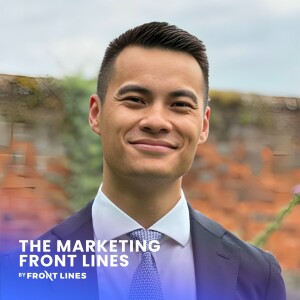
Friday May 16, 2025
Friday May 16, 2025
In this episode of Marketing Front Lines, we speak with Bobby Vo, Head of Growth at Authentic. Authentic is transforming commercial insurance through embedded solutions for vertical SaaS platforms, franchisors, and affinity groups. Bobby shares his journey building a growth strategy from scratch at a Series A insurtech startup, redefining partner enablement in a traditionally commoditized industry, and creating product-led experiences that drive word-of-mouth adoption despite the challenges of marketing insurance products.
Topics Discussed:
Building trust with partners through hands-on product demos and visualization
Creating a two-pronged education strategy targeting both partners and end customers
Developing a content strategy focused on case studies and white papers
Implementing platform-centric marketing rather than relying solely on traditional channels
Finding marketing inspiration from consumer brands outside the B2B space
Navigating prioritization challenges as the sole marketing leader in a Series A startup
Lessons For B2B Marketers:
Look Beyond Traditional Customer Feedback: Instead of blindly following customer requests, learn to interpret the underlying needs. As Bobby explains, "It's not just blindly listening to whatever your customers say. It's reading between the lines and understanding what's going to drive value for them." This approach helps you solve problems customers may not even realize they have.
Make Your Platform the Marketing Centerpiece: Resist the temptation to rely solely on traditional marketing channels like email. "Marketing can't just solve all your problems. You have to use your platform as a way to market," Bobby advises. The most effective B2B marketing leverages the product experience itself to demonstrate value and drive adoption.
Build Partner Enablement Through Visualization: When working with partners who will represent your product, prioritize "seeing is believing" education. Bobby's approach centers on visual learning: "Make sure your partners are able to speak to the product by themselves without us in the room." Equip partners with demos, customer testimonials, and tangible evidence they can use independently.
Adapt Marketing Strategies to Partner Communication Styles: What works for one partner may fail with another. Bobby learned that "if partners are used to talking through their app, an email is going to come off as spam." Study how your partners communicate with their customers and align your marketing approach accordingly.
Find Inspiration Outside Your Industry: The most innovative B2B marketing ideas often come from consumer brands. Bobby draws inspiration from Trader Joe's and Celsius—companies that transform commodities into cult followings through exceptional experiences rather than traditional advertising. "I love word of mouth, deep customer experience," he notes, seeking ways to apply these principles to B2B insurance.
Use AI as a Thought Partner, Not Just a Content Generator: Bobby uses ChatGPT not to produce finished content but to quickly test hypotheses: "I use it to arrive at answers quickly... as a thought partner rather than a content generator." This approach helps him "spit out the bad pancake" early and refine his thinking faster.
Embrace Strategic Failure in Early-Stage Growth: In a Series A environment, you won't have all the answers. Bobby recommends optimizing for speed and learning: "Try to optimize your speed to trying something, then fail and get the lessons quickly." Don't get trapped in analysis paralysis—determine what's "good enough" to test and iterate from there.
//
Sponsors:
Front Lines — We help B2B tech companies launch, manage, and grow podcasts that drive demand, awareness, and thought leadership.
www.FrontLines.io
The Global Talent Co. — We help tech startups find, vet, hire, pay, and retain amazing marketing talent that costs 50-70% less than the US & Europe.
www.GlobalTalent.co
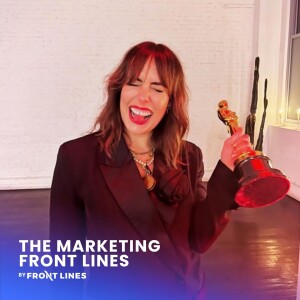
Friday May 16, 2025
Friday May 16, 2025
In this episode of Marketing from the Frontlines, we speak with Fay Scott, VP of Marketing at April, a fintech startup creating embedded tax solutions. Fay joined April at the Series A stage and built their marketing function from the ground up, establishing a category in embedded tax while navigating the challenges of startup brand evolution. Drawing from her psychology background and 12 years in agency work, Fay shares her framework for disruptive brand strategy and explains how she's positioning April to serve increasingly complex tax use cases.
Topics Discussed:
Creating a category in embedded fintech (embedded tax)
Building brand strategy through psychological research and customer segmentation
Navigating brand evolution in startup environments
Transitioning from agency work to in-house marketing leadership
Managing brand positioning during crisis (Robinhood post-GameStop)
Targeting unmet needs in complex tax scenarios
Brand strategy refresh cycles in startups vs. established companies
Risk-taking in marketing campaigns and preparing organizations for polarizing reactions
Lessons for B2B Marketers:
Prioritize Research for Brand Strategy Development: Fay conducted a 4,000-participant segmentation study of taxpayers to identify specific profiles, unmet needs, and financial behaviors. This data-driven approach informed both product development and partnership targeting in their B2B2C model.
Approach B2B Marketing with Emotional Intelligence: B2B buying decisions are highly emotional because stakeholders' jobs and livelihoods are on the line. Rather than focusing solely on features and functionality, elevate messaging to address the emotional aspects of business decisions.
Create Category Differentiation Through Three Disruptor Elements: Fay's disruptor brand framework requires: 1) having a clear point of view on the category problem, 2) solving a specific unmet need for a particular customer type, and 3) appearing in unexpected places where competitors aren't present.
Recognize Brand as a Business Multiplier: Brand is not just marketing—it's a promise and the external articulation of your strategy. While good products can succeed without strong brands, they operate at "1X." Adding strong branding creates a multiplier effect that attracts stakeholders and creates excitement.
Build Brand Strategy for Complex B2B Products: For April's embedded tax category, Fay reframed the conversation from "adding tax services" to focusing on the business value unlocked through tax embedding—customer data insights, deposits, and improved retention.
Leverage Agency Experience for In-House Roles: Agency work provides exposure to different industries, mediums, and marketing challenges—functioning like an MBA for marketers. This breadth of experience prepares marketers to handle various challenges when moving in-house.
Expect Accelerated Brand Refresh Cycles in Startups: While large companies like IBM might reposition every 10-15 years, startups need brand refreshes every 2-3 years. Be prepared to iterate quickly based on market signals and evolving product-market fit.
Prepare Organizations for Brand Risk-Taking: When planning potentially polarizing campaigns, prepare the organization by building a business case based on projected organic impressions and establishing a clear path to convert attention into revenue.
//
Sponsors:
Front Lines — We help B2B tech companies launch, manage, and grow podcasts that drive demand, awareness, and thought leadership.
www.FrontLines.io
The Global Talent Co. — We help tech startups find, vet, hire, pay, and retain amazing marketing talent that costs 50-70% less than the US & Europe.
www.GlobalTalent.co
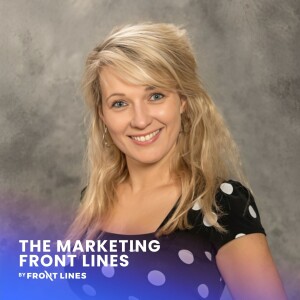
Thursday May 15, 2025
Thursday May 15, 2025
In this episode of Marketing from the Frontlines, we speak with Táňa Rulková, VP of Marketing at TipHaus, a hospitality tech solution focused on tip management. With deep roots in the hospitality industry and a passion for beverage brands, Táňa shares how she built a lean, high-performing marketing team that produced over 50 case studies in just one year. Her approach combines strategic inbound marketing with tactical customer storytelling, creating a powerful engine for growth in a highly specialized B2B SaaS space.
Topics Discussed:
Building an effective marketing strategy from scratch at a growing tech startup
Creating a high-volume case study program that drives sales and product feedback
Managing a lean marketing team with strategic use of part-time specialists and agencies
Balancing freedom and agility in smaller organizations vs. structured processes in larger companies
AI integration in daily marketing operations for content optimization and image generation
The shift away from traditional trade shows toward more targeted digital events
Lessons For B2B Tech Marketers:
Structure First, Then Scale: When taking over marketing leadership, prioritize foundational elements before tactical execution. Rulková's first 30 days focused on sales alignment, customer pain point discovery, audience segmentation documentation, and messaging frameworks—creating the structure needed for everything that followed.
Merge Customer Success with Content Strategy: Instead of treating case studies as standalone marketing assets, use the interview process as a multi-purpose engine. Each customer conversation becomes an opportunity for product feedback, feature prioritization insights, and relationship building, while simultaneously creating marketing content.
Implement Precision-Based Team Building: Rather than hiring generalists or full-time specialists for every function, Táňa built a core team (content + leadership) supplemented by part-time specialists (design + web development) and cyclical agency relationships (PR). This approach provides specialized expertise without the overhead of full-time headcount.
Adopt "Helpful Friend" Positioning in B2B Marketing: Instead of focusing on outbound interruption tactics, position your marketing as the helpful resource that answers specific questions prospects are already asking. This philosophy drives SEO strategy, content development, and the overall approach to market presence.
Implement Smart PR Cycling: For high-impact PR that doesn't break the budget, use a cycling strategy. Rather than maintaining expensive year-round agency relationships, engage experts for targeted 2-month campaigns around specific announcements, then pause until the next major milestone. This provides specialized expertise when it matters most without ongoing retainer costs.
Leverage AI to Replace Junior Functions: Rather than hiring marketing assistants or interns who require significant training and supervision, use AI tools to handle repetitive tasks like proofreading, content editing, and first drafts. This allows small teams to focus their human resources on strategy and relationship-building activities.
//
Sponsors:
Front Lines — We help B2B tech companies launch, manage, and grow podcasts that drive demand, awareness, and thought leadership.
www.FrontLines.io
The Global Talent Co. — We help tech startups find, vet, hire, pay, and retain amazing marketing talent that costs 50-70% less than the US & Europe.
www.GlobalTalent.co

